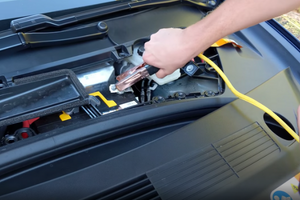Will 12 Volt batteries still be used in EVs?
As electric vehicles become more popular and the sale of new petrol or diesel vehicles is set to be banned in 2030, many will wonder what will happen with all the 12V components?
Can you still use a low voltage fridge with an EV camper? What about 12-volt switches? As a business, this has been something we have also had to look into as we want to make sure we keep ahead of the changing market and continue to offer products suitable for all customers.
Thankfully, it looks like 12 Volts will be staying just a little longer even with the introduction of electric vehicles; but why? Well, this is because a lot of components are already made for 12V and why re-invent the wheel? Wiper relays, switches, lights and other accessories already exist for vehicles and re-designing and manufacturing these items to run from the higher voltage batteries used for driving (typically 400V or higher) would be expensive and time-consuming and something that manufacturers would factor into the cost of new vehicles.
Keeping the system on a lower voltage also prevents high voltage shocks which could be fatal, making changing a bulb a little scarier than it needs to be. With the systems remaining on the lower voltage starter battery, the risk is reduced. It also means that, in the event of a crash, first responders will not have to worry about potentially dangerous high voltages running through the vehicle.
By sticking with the current 12 Volt batteries it means manufacturers can use existing technology and thereby reduce costs, but how exactly does it work? The starter battery operates just as it does now, running all the low voltage equipment such as radios, lights, electric windows, etc, and is also still used to start the vehicle because the ECU and other onboard computers will be using the low voltage supply to operate as they do now. This also means if your low voltage battery goes flat your EV vehicle can not be started, regardless of how much charge is in the drive motor battery. As an EV vehicle does not have an alternator, the starter battery will be charged using a DC-DC converter which will step the 400V or higher down to around 14V to recharge the starter battery when the vehicle is in motion. If your starter battery is flat, however, it can be jump-started just like petrol or diesel vehicles and some manufacturers have built-in jump starting features using the high voltage battery system.

Tesla model 3 starter battery
So in conclusion, it looks like 12 volt batteries will be sticking around a while thanks to their safety record, low-cost components & advancements over the last 20 years; but what do you think? Let us know in the comments down below.
